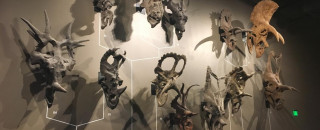Research Quest Digs Into Horned Dinosaurs
Utah is a hotspot for horned dinosaurs. © NHMU
By Riley Black
Everyone knows Triceratops. The huge, "three-horned face" has been a dinosaurian icon ever since the late 19th century. But the hulking herbivore is hardly the only dinosaur of its kind. In the last two decades paleontologists have named a slew of previously-unknown species of horned wonders - including several unique to Utah. Taken together, these dinosaurs - known as ceratopsids to experts - display an incredible diversity of species and shapes, making them perfect to teach Research Quest students about how paleontologists interpret the fossil record.
"We have some fantastic research, particularly in Utah, around horned dinosaurs," says NHMU Associate Director of Education Initiatives Madlyn Larson. The dinosaurs Kosmoceratops, Utahceratops, Nasutoceratops, and Diabloceratops are all recent finds from Utah, and NHMU paleontologists have been involved in the descriptions of species found in other locales, as well. That Utah has become such a focal point for ceratopsid research made these dinosaurs a perfect fit for a new Research Quest investigation about evolution and how traits can be used to both distinguish individual species and follow evolutionary patterns over time.
It's hard not to be impressed by animals that were practically bristling with incredible ornaments - Kosmoceratops had 15 horns on its head - and that "wow factor" contributes to the new unit's focus. Horned dinosaurs, Larson notes, underwent a relatively short period of diversification where many new species appeared in a relatively short amount of time compared to other dinosaurs. The question is why, and that mystery is certainly part of the appeal.
Designed for middle school students as part of their science curriculum, the Research Quest investigation builds on observations about different ceratopsian dinosaurs, starting from anatomical observations about physical traits to how horned dinosaurs were related to each other and where in the world they lived. The flow of the investigation follows how many paleontologists work through these same questions, working through observation, hypothesis, and theory about creatures that have been extinct for more than 66 million years. "Our goal is to provide students with an opportunity to work on research questions that our own researchers pursue," Larson says, encouraging students to take an independent role in investigating these real scientific questions.
Cultivating these research skills applies to more than just the these fantastical lizards. Through Research Quest, Larson says, "I hope students better understand how the scientific enterprise works, and how we know what we do about the world around us." Learning how ceratopsian dinosaurs were related to each other, for example, can help students apply the same skills to other forms of life. "It's a process and a group of phenomena that can be applied to other organisms," Larson says, with the dinosaurs being just one example of natural phenomena that are all around us. "When you understand the forces around you," she says, "you can enhance your appreciation of it."
Learn more about Triceratops Traits and Research Quest
Riley Black is the author of The Last Days of the Dinosaurs, Skeleton Keys, My Beloved Brontosaurus, and is a science writer for the Natural History Museum of Utah, a part of the University of Utah in Salt Lake City. Our mission is to illiminate the natural world and the place of humans within it. In addition to housing outstanding exhibits for the public, NHMU is a research museum. Learn more.
